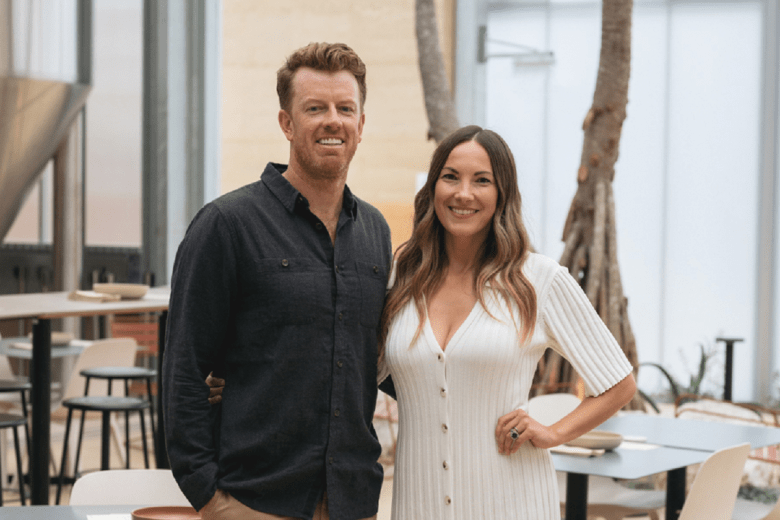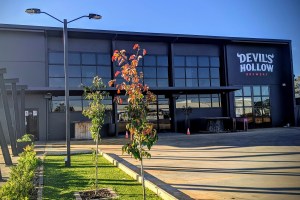Communal singing groups unite people through casual, joyful experiences blending beer and song, fostering connection and rediscovery in community spaces.
The post Singing For Your Beer: Hops & Hymn appeared first on CraftBeer.com.
Communal singing groups unite people through casual, joyful experiences blending beer and song, fostering connection and rediscovery in community spaces.
The post Singing For Your Beer: Hops & Hymn appeared first on CraftBeer.com.
 Ginger beer will debut as a category at next year’s Royal Queensland Beer Awards awards.
Ginger beer will debut as a category at next year’s Royal Queensland Beer Awards awards.  After a period of review and consultation Lion has made the ‘difficult decision’ to close its Malt Shovel Brewery.
After a period of review and consultation Lion has made the ‘difficult decision’ to close its Malt Shovel Brewery. A new wave of Asian American brewers is putting their heritage at the heart of their craft.
The post Redefining Craft Beer: Asian Americans Brewing Up Heritage appeared first on CraftBeer.com.
 Ahead of Modus Brewing’s 10th anniversary celebration this weekend, we chat with Co-Founder Grant Wearin about his highlights from the past decade.
Ahead of Modus Brewing’s 10th anniversary celebration this weekend, we chat with Co-Founder Grant Wearin about his highlights from the past decade.  John Blichmann joins me this week to discuss the evolution of home brewing equipment from the late 1980’s to the current day. Subscribe on iTunes to Audio version or Video version or Spotify or Google Play Download the MP3 File– Right Click and Save As to download this mp3 file. Your browser does not support […]
John Blichmann joins me this week to discuss the evolution of home brewing equipment from the late 1980’s to the current day. Subscribe on iTunes to Audio version or Video version or Spotify or Google Play Download the MP3 File– Right Click and Save As to download this mp3 file. Your browser does not support […] Smoothie sours are attracting a whole new audience of beer drinkers that otherwise would not make their way into a brewery.
The post Cheesecake and Ice Cream and Blueberry, Oh My: The Allure of Smoothie Sours appeared first on CraftBeer.com.
In 2019, The Full Pint as a media outlet was at it’s peak in terms of content creation and an influential media outlet. It was that year that we decided […]
The post Well Wishes to Isaac! – Octopi Brewing Has Been Acquired By Asahi appeared first on The Full Pint - Craft Beer News.
In 2019, The Full Pint as a media outlet was at it’s peak in terms of content creation and an influential media outlet. It was that year that we decided […]
The post Well Wishes to Isaac! – Octopi Brewing Has Been Aquired By Asahi appeared first on The Full Pint - Craft Beer News.
Taprooms have long been community meeting places, and now some are choosing to welcome that community bright and early by using their buildings as coffee shops and all-day workspaces.
The post Rise and Shine: Brewers Add Coffee & Workspaces appeared first on CraftBeer.com.
(BEND, OR) – Deschutes Brewery’s The Dissident has been a staple of the Reserve Series and a popular pick for craft beer collectors since 2008. Up until 2019, this barrel-aged Flanders […]
The post Deschutes The Dissident Cherry Variant Returns appeared first on The Full Pint - Craft Beer News.
Jerry Franck, an Academy Award-nominated documentary filmmaker, followed a few notable lambic breweries to help sustain what many see as an anachronistic approach to beer making.
The post The Coolship Has Landed: Film Elevates the Art of Lambic Brewing appeared first on CraftBeer.com.
This July marks five years since I left my day job with the federal government to brew full-time. We filled our first barrel with mixed-fermentation saison before opening the tasting room at Sapwood Cellars. Since then, we are up to 80 oak barrels with a dedicated suite for mixed-fermentation. So, I thought it would be a good time to sit down and reflect on the lessons that Scott and I have learned over the years! The things we got right, the things we got wrong, and where we are going from here!
Luckily, we've had a pretty good run so far! We've cultivated a great group of supporters in our Wood Club. Neologism (gin-barrel-aged Cascade/Simcoe Cryo dry-hopped pale sour) was named one of Craft Beer & Brewing's Top-20 beers of 2022 by way of winning a massive blind tasting. Despite the pandemic we've been able to modestly expand (production, staff, and space)! We're even shipping beers around the US through Tavour!
I recently realized that Google discontinued Feedburner in 2021... which is why you haven't gotten an email from me in a while. I've changed The Mad Fermentationist over to a new email service, so if you've signed up you should get emails for new posts going forward! If you want more emails from me, I write the near-weekly Sapwood Newsletter (with details on new beers often including info on ingredients, process, and equipment)!
Diverse Microflora - It is certainly simpler to have a single "house" culture. It allows for relatively worry-free blending, but doesn't leave as much room for unique flavors. Maintaining multiple cultures, we have to worry about the microbes from one barrel over-attenuating in the bottle if they are more attenuative than others in the blend. However, the variety of flavors expressed and the options for blending is worth the effort at our scale. We've been even happier since we started selecting our favorite barrels and using them to inoculate subsequent batches. Now we can select which character fits a pale sour vs. a sour red.
Last week we blended our second batch of Growth Rings (three year blend). To ensure all the microbes have time to get to know each other, we blended the four barrels (all different pale base beers) into a tote. They'll sit there for a couple months to ensure the gravity is stable before priming and bottling.
Balancing Planning and Creativity - We started 2023 with a rough timeline of the 20 or so barrel-aged mixed-ferm we'll release. However, when we fill barrels there generally isn't a specific plan for which barrel will be in which beer. Pale, wine-barrel-aged beer can be delightful on it's own, or serve as a great base of fruit, herbs, or dry hopping. When we taste them, we get to decide what will make the best possible beer. However, it's also nice to have unique bases/barrels earmarked for a particular purpose. Some examples of those include Opulence (sour red with dried sour cherries in the bourbon and red wine barrels), a Brett'd Belgian Tripel in Calvados (apple brandy), or Port barrels for There Are No Edges (Vin de Céréale).
Tracking Barrels - Using Google Sheets has worked out well for us. I can sort based on fill date, final gravity, base beer etc. It allows me to sit on my couch at home and look at what beers we have in need of fruit, blending, packaging etc. Barrels still fall through the cracks (nothing is more heartbreaking than tasting a barrel that is old/stale and seeing a note about how good it was six months ago). Sometimes a beer is delicious, it just doesn't fit into a blend.
Blending with Others - Whether it is our tasting room manager (Spencer), Lead Brewer (Ken), homebrewing friends, fellow brewers (e.g., the brewers from Other Half for a collab) etc. Tasting barrels with other people helps improve your palate, riff on ideas, and make more broadly appealing results. We all have flavor "blind spots" and it is a good idea to have other people looking too. It's fun to riff off other people's ideas and come up with flavor combinations that neither of you would have made on your own.
Packaging - Our general approach to packaging has been a big success... once we started measuring the dissolved CO2 in the beer rather than relying on time/temperature/pressure. We blend barrels or transfer fruited beers to our blending tank and cold crash. The day before bottling we'll push in sugar (boiled in water) along with Premier Cuvee champagne yeast (rehydrated with a small amount of Start-Up/GoFerm nutrient). We then carbonate the beer to ~2 vol of CO2, with the sugar and yeast taking the beer the rest of the way. We fill on a bottler (XpressFill) that purges and counter-pressure fills. So far it's resulted in relatively quick/clean refermentations with reliable carbonation.
Not Allocating Time - It is easy to put-off barrel-aged beers for more pressing concerns. When there are DIPAs to dry hop, Pilsners to can, and excises taxes to exercise the sour beers are often pushed to the side. It's rare that a week or two of aging in one direction or another makes a dramatic difference... but it's hard to get the most out of a barrel program if it is always at the bottom of the priority list. We're getting better at it, but I still wish from the start I'd blocked off a specific time/day each week to taste barrels, trial blends, source ingredients, prop microbes etc.
Over-Correcting - Initially we weren't getting enough acidity in some of our beers, so we started pulling levers... colder rinsing barrels, lower hopping rates etc. Then our beers started becoming too sour, so we started veering back in the other direction. Managing a barrel program is like driving a cruise ship, it is difficult to pivot quickly! It's difficult to step back and tell if there is something causing one specific batch from being too sour (or not sour enough) or if there is a systemic issue.
I think we would have been well served to do a better mix starting early (some barrels cold or no-rise, more with just Brett etc.). This would have given us more options when it came to blending over- or under-soured beers.
Appreciating the Impact of Fruit On Acidity - Early on to help out some of those under-acidified beers, we went onto fruit. I was surprised how little additional acidity they picked up from refermentation. Sure adding a really acidic fruit (e.g., black currants for Fellow Feeling) contributed acidity, but just refermenting on wine grapes or peaches did not. However, as our cultures "matured" we suddenly had beers dropping from a tart pH of 3.5 to an obnoxiously-acidic 3.0 after going onto the fruit (2.8 pH was the lowest I measured). That's despite pitching rehydrated wine yeast to ensure a healthy and quick refermentation.
I thought maybe our resident lactic acid bacteria were becoming more hop tolerant, and the dilution of the beer with fruit was allowing them to kick into action. To test this we began adding a small amount of hop extract with the fruit (we use a 20% alpha extract from Hopsteiner). Our fruited beers stopped dropping pH nearly as much, and as an added benefit the head retention improved considerably.
Hot Side Hopping - I didn't appreciate how much of the classic funky lambic/saison profile originates with the hops. While we've always used a "restrained" dose of aged hops at the start of the boil (~.5 lbs/bbl), that just wasn't enough to give the beers the aromatic depth I was looking for. Recently we've been experimenting with a similar size whirlpool addition of cold-stored hops. So far the results are promising! I should have noticed that many of my favorite homebrewed Brett Saisons had big whirlpool additions and/or dry hopping... but those were all relatively quick turn-around and not barrel-aged. I'm glad Scott and Ken pushed to age some of our pale ales (pre-dry hopping) in barrels, an idea I wasn't excited about... but the results have been really delicious!
Barrel-aged sour beer seems to be a wide/shallow market at the moment. The people who love them are still searching them out, but the average beer drinker seems to have moved on to less "challenging" more "reliable" styles. It's hard to know how much the rapid expansion of the segment played into this loss of interest. I've heard of quite a few breweries down-sizing or eliminating barrel-aged sour beers... Luckily we still have 150 people in our Wood Club, which is a great way for us to get these beers into the hands of our biggest supporters and a base-level of sales for eight releases a year. We're aiming to make our mixed-ferm beers more "delicious" the sorts of beers that people want to drink a whole bottle of, not just drink an ounce or two at a share.
However, as we've ramped up the mixed-ferm bottle release schedule (2019 - 8, 2020 -11, 2021 - 13, 2022 - 16, and hopefully ~20 in 2023) we occasionally have bottles to spare. Rather than distribute them locally, we've partnered with Tavour (which ships to many states). They just released Homegrown Rule, a "Marylanbic" base with homegrown lemon verbena (from my yard) and pineapple sage (from Ken's garden). It's tart and snappy, with plenty of our house microbe character, augmented by the citrusy-green notes of the herbs.
In a way, purchasing the Black Elks’ building was like coming home for Ken Carson. The building sits in a part of Albuquerque, N.M., he describes as “the ’hood.” Carson once lived here before moving to the more affluent Northeast Heights in the 1960s, where he attended high school with only three other Black students. […]
The post Soul Food and Cream Ale in Albuquerque appeared first on CraftBeer.com.
As the craft industry’s demographics change, what can Beer City USA teach us about how history impacts beer today?
The post A Walk through History and Race in Beer City USA appeared first on CraftBeer.com.
History and beauty. The Brandywine Valley is steeped in both. With the crisp fall weather, there’s no better time to go on a brewery road trip.
The post The Hills of Beer Are Alive in the Brandywine Valley appeared first on CraftBeer.com.
From brewery hotels to campgrounds, quirky Airbnbs to luxurious resorts, this is your guide to planning a craft beer weekend getaway.
The post AirbnBeers: Breweries with Hotels, Inns, Camping and More appeared first on CraftBeer.com.
When Bhavik Modi walked into his first ever sales meeting for his new craft beer line, he wasn’t alone. Tiffany Wooten, a veteran sales representative from brewery incubator Pilot Project Brewing, was by his side, convincing the team at high-end contemporary Indian restaurant ROOH Chicago to serve Azadi Brewing’s cardamom golden ale and Kesar mango […]
The post Pilot Project: Launching Brands and Lowering Barriers in Craft Beer appeared first on CraftBeer.com.

Dubbo's first craft brewery is for sale with the Devil’s Hollow Tavern and Brewery hitting the market after launching in July 2019.
The post Dubbo’s Devil’s Hollow Brewery for sale appeared first on Beer & Brewer.
The roots of American craft beer extend throughout the nation, but the bines of the movement are clearly embedded in the Pacific Northwest.
The post 5 Pacific Northwest Breweries to Please Any Palate appeared first on CraftBeer.com.
Nothing attracts customers to a brewery more than incredible beer. But a close second? An incredible location!
The post Revitalizing Neighborhoods and Reigniting Memories appeared first on CraftBeer.com.
 This week Mark Edelson joins me from Iron Hill brewery to discuss how he makes operational decisions across his 19 Craft brewery locations. Subscribe on iTunes to Audio version or Video version or Spotify or Google Play Download the MP3 File– Right Click and Save As to download this mp3 file. Your browser does not […]
This week Mark Edelson joins me from Iron Hill brewery to discuss how he makes operational decisions across his 19 Craft brewery locations. Subscribe on iTunes to Audio version or Video version or Spotify or Google Play Download the MP3 File– Right Click and Save As to download this mp3 file. Your browser does not […] 
Barossa brothers back up their 2019 success with a host of trophies including Best in Show.
The post Barossa Cider Co crush Australian Cider Awards again appeared first on Beer & Brewer.
From Dovetail Brewery: In 2018 we released a 2-year (16-17) blend (Petite Gueuze), in 2019 we released a 3-year (16-18) blend (Vignette), and this year we are released our 4-year (16-19) blend (Vignette 2020). Expect notes of tropical fruit, Chardonnay, oak, orange peel, honey, vanilla. Dovetail Brewery – Dovetail Vignette 2020 – Served in 5 […]
The post Reviewed: Dovetail Brewery Vignette 2020 appeared first on The Full Pint - Craft Beer News.
(Minneapolis, MN) – By investing in innovation and committing to expanding its presence in Milwaukee and Wisconsin, Minneapolis-headquartered Indeed Brewing Company grew its total production to 17.5K barrels sold in 2021, up more than 20 percent in 2020 and up 38 percent from 2019. Brand Innovation in 2021 Led by the success of its flagship brands, Indeed […]
The post Indeed Brewing Looks Back on 2021 and Ahead on 2022 appeared first on The Full Pint - Craft Beer News.
From best brewer to best new brewing company, find out who won our industry awards.
The post Beer & Brewer’s 2021 Industry Award winners appeared first on Beer & Brewer.